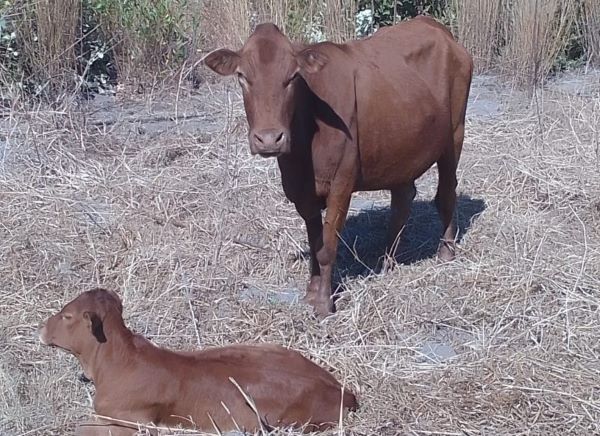Calving difficulty, or dystocia, poses significant challenges for cattle producers, leading to increased calf losses, cow mortality, veterinary expenses, and labour costs, as well as delayed return to estrus and reduced conception rates. A USA study highlighted the economic impact of this issue, estimating annual losses at approximately $25 million. Furthermore, cows that experienced assistance during previous births showed a 16% lower pregnancy rate after the entire 70-day breeding season, underscoring the long-term effects of calving difficulties on herd productivity.
According to Thapelo Kgosi Ramokala, also known as King, animal health specialist at Beefmaster Group, factors that influence the incidence of dystocia include the age of dam (cow), the calf’s birth weight, the dam’s pelvic area as well as the pre-calving nutrition and condition of the dam.
“Most of these can be grouped into two classifications; factors affecting size and shape of calf, as well as factors affecting the ability of the dam to give birth,” says King.
Data from the Marc and Colorado State University illustrates that a dam’s age has a profound effect on the incidence of dystocia.
“First-calf, 2-year-old heifers pose the greatest challenge when it comes to calving difficulty, with the incidence being three to four times higher than in 3-year-old cows. The higher rates of dystocia among these young heifers are primarily because they are smaller at their first calving compared to subsequent births, making the birthing process more difficult,” says King.
Calf birth weight and calving difficulty
When comes to the calf’s birth weight, King says that the birth weight and calving difficulty are correlated.
“An increase in gestation length can increase bight weight by 0.2kg to 0.4kg per day of gestation.”
Studies show that the continuous selection for increased weaning weight and growth rate resulted in dramatic increases in the birth weight of beef calves.
“The effect of birth weight on dystocia should be thought of as a ‘threshold’: the point where birth weight is just large enough that a slight increase will substantially increase dystocia is called the threshold. Selection for reduced birth weight will not reduce dystocia, within a given cow size,” says King, adding that a selection of beef breeds based on muscle development and growth rate early in life can lead to an increase in birth weight and calving difficulty.
Cow pelvic area and breed specifics
King says that the Pelvic area has a considerable influence on the incidence of dystocia. The incidence of calving difficulty is twice as high in heifers with a small pelvic area when compared to heifers with a larger pelvic area (49% vs 24%).
Just like birth weight, pelvic area is a threshold trait.
“The ratio of birth weight / pelvic area is an extremely important factor. The bottom line on pelvic area is that: females with a decreased pelvic size that carry large calves, will experience calving difficulty every time, and may produce offspring with calving difficulties since pelvic area is highly heritable (±55%). Producers who would like to reduce the incidence of dystocia in their herds should select for increased pelvic size and consider taking pelvic measurements,” says King.
Breeding bulls also influence the pelvic size of offspring. “Thus the farmer should consider that the pelvic width is important with Bos Taurus bulls and pelvic height is important with Bos Indicus bulls.”
Pre-calving nutrition and the condition of the Dam
Many cattle producers believe reducing dietary energy during late pregnancy will decrease foetal size and result in improved calving ease, while increasing energy may increase foetal size and lead to a higher incidence of dystocia. However research in recent years suggests that while birth weight can be reduced due to limited cow nutrition, calving difficulty is actually increased when cows are underfed even if the calving weight is lower. Increasing the level of dietary energy resulted in increased birth weights but not increased dystocia.
“Overfeeding cows to the point of obesity increases the incidence of dystocia while underfeeding to the point that cows become emaciated and weak will likewise also increase calving difficulty,” says King.
Recent research suggests that overfeeding of protein during the last three months of gestation my lead to increased birth weights and dystocia. Although producers should not be encouraged to underfeed protein, because this could result in “weak calf syndrome”.
Below are King’s top 10 tips for reducing calving difficulty and increasing chances of success:
- Focus on both genetics and management to reduce dystocia—genetic solutions take longer, but better herd management has a quicker impact.
- Consider birth weight as a key factor when aiming to reduce calving difficulties.
- Ensure heifers weigh at least 65% of their mature weight at first breeding and 85% at first calving.
- Mate first-time calving heifers and smaller cows to bulls known to sire smaller calves; evaluate estimated birth weight and the bull’s physical structure.
- Measure pelvic area in replacement heifers and cull those that are too small—aim for at least 160cm² in medium breeds and 180cm² in larger breeds.
- Avoid retaining daughters from cows with a history of calving difficulty.
- Breed heifers 21-30 days earlier than cows to allow more observation time during calving.
- Feed pregnant females adequately—avoid both underfeeding and overfeeding.
- Be cautious with implanting zeranol; it increases pelvic size but may reduce conception rates and lead to abortions.
- Remember that bull calves have a 5% higher chance of causing calving difficulties than heifer calves.








